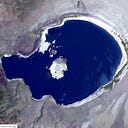Project>Mono
Balance
We’re all connected. The sooner we realize that and really take it to heart, the better we’ll be for it.
We’ll be better able to tackle the important work of trying to restore balance to disrupted ecosystems that maintain the web of life on Earth. And that can help us heal some of our own wounds and trauma that seem to drag us down.
One of the places that helped me understand how it all fits together, what’s broken, and how to fix it, is Mono Lake, an ancient body of water that has persisted for 760,000 years through great glacial epochs, megadroughts, tectonic upheavals and fierce volcanic outbreaks.
How did this ecosystem manage to survive all that? The answer, I think, is balance. And you can’t think of balance as some static point on a mechanical scale. In nature, it’s a dynamic process that’s constantly shifting within a certain range.
I first came to the Mono Basin to ski. That delicate dance with gravity on steep snow-covered slopes was my own way of seeking balance at the time, a moving meditation that opened the door to thinking about my relationship with nature.
After a few months of scrambling from the lowland alkali sage sinks and pumice flats up to the glacier-gouged granite monoliths around Tioga Pass, I started to feel how the mountains and desert are connected, and how the processes in both places created a balance that enabled the lake to persist.
The snowy couloirs, remnant glaciers and permanent snowfields are more than a mountain playground, of course. They are the frozen reservoirs that provide water during dry seasons and years. They feed alpine lakes and wetlands resting in ice-scoured basins, then plunge several thousand vertical feet to sustain Mono Lake with fresh water.
The same cycle existed in past eons, on a much larger scale. Instead of creeks, thick rivers of ice filled the canyons and spilled out into the lowlands. Mono Lake spilled over into adjacent valleys and perhaps even connected with a pleistocene sea in what we now call Death Valley. At one point, giant sequoias grew in our modern-day deserts. Perhaps the glaciers even calved icebergs directly into the prehistoric version of the lake.
We know is that Mono Lake was several hundred feet higher than now because there are giant fossilized springs high up the sides of mountains around the lake, and their tufa skeletons have detailed information about their age. As those ice age glaciers receded, they pumped huge surges of fresh water into the lake.
In drier eras, the lake may have shrunk to somewhere around the size it is now, but it persisted. It never went away completely, even during the most extreme climate and geological changes, as the undisturbed systems were adaptable enough to stay balanced in extreme conditions.
The only thing the lake couldn’t survive was the sudden cutoff of nearly all the tributary streams in 1941, when Los Angeles built an aqueduct to siphon the fresh mountain water to the city. The lake level started dropping at faster rate than probably at any time during recent geological history, dwindling toward a fate similar to the Aral Sea.
But something amazing happened at Mono Lake to change that seemingly inevitable trajectory. The winter before I visited the area for the first time brought massive amounts of snow. Los Angeles couldn’t control all the water coming down the creeks, and it spilled over the diversion dams, carrying trout and seed and sprigs that sprouted green in just a few months.
I joined the Mono Lake Committee as an intern, and camped along Lee Vining Creek, documenting live trout in what had been a rocky arroyo for several decades. Local anglers took notice and went to court to keep the water flowing. The subsequent legal proceedings are well documented, and what’s striking is that the results found a mostly positive resonance in society, which is a hopeful sign for all of us, I think.
Now, the Mono Basin is a landscape-scale experiment in ecosystem restoration that can be an inspiration and informational model that must be used in other places to restore the natural balance we’ve disrupted in so many ways that it threatens the continued existence of life on Earth.
Read:
*This reporting project is partly supported by the University of Colorado, Boulder, Center for Environmental Journalism Water Desk.

